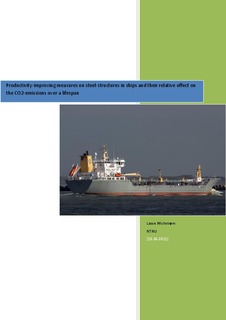| dc.contributor.advisor | Hagen, Arnulf | nb_NO |
| dc.contributor.author | Wichstrøm, Lasse | nb_NO |
| dc.date.accessioned | 2014-12-19T12:07:01Z | |
| dc.date.available | 2014-12-19T12:07:01Z | |
| dc.date.created | 2012-04-12 | nb_NO |
| dc.date.issued | 2011 | nb_NO |
| dc.identifier | 515302 | nb_NO |
| dc.identifier.uri | http://hdl.handle.net/11250/238070 | |
| dc.description.abstract | Although maritime transport are surely the most environmentally friendly way to transport , number of tones cargo shipped versus total CO2 emissions, is it great opportunities and possibilities for further improvement. A life cycle assessment is a technique to assess environmental impacts associated with all the stages of a product's life from-cradle-to-grave. LCA analysis is not as common in the shipping industry, but is on its way to becoming an important tool to outline and hopefully reduce emissions. It has earlier been shown that the operation phase is the phase where a ship pollutes the most during a lifetime[1], so the main goal in this thesis is to take a look into the consequences of designing a simplified (efficient to produce) ship structure and the effect this has on the total amount of CO2 emissions trough the ships lifecycle.
Building as cheap as possible has always been important in the shipping industry, one way to cut the building cost can be to simplify the steel structure of the ship and in that way reduce the man hour cost. In a collaboration with the MARINOR project "production and maintenance friendly steel constructions" (source [2]) a rapport containing results from strength analyzes on a ship structure was made. The goal was to reduce or remove number of profiles, results showed that this was possible with a moderate increase in plate thickness. The chosen sample ship could remove 943 profiles with a following dead weight increase of 30 tons for a 17,500 dwt product tanker. This case has then been used to evaluate the effect a simplified steel structure has on the total emissions of CO2 during a ships lifetime. Results from the MARINOR project has been generalized to fit other ship sizes and results from the LCA showed the following results:
Emissions from the building phase alone is about the same, only about 0,5 percent raise and that is mainly due to higher lightship weight. The saved emissions due to less welding, burning and edge trimming are not enough to actually bring some difference to the total emissions.The added steel weight is too little to give added emissions in the operation phase alone.The difference between the two ship structures are mainly the operation profile and the added life length of the ship.With the assumption of a added life length from 20 to 30 years the factor( g CO2 / Ton Freighted x Nm) have improved from 1,5 to 4 percent depending on the ship size, the reason is added lifetime and less steel replacement. Results show that the ships with higher Dwt/lightship factor trends to have higher environmental effects of a simplified steel structure.
At the economical point of view a ship with a simplified steel structure seems to cost about the same as a conventional design. With the assumption of an added lifecycle are the new design is about 30 percent cheaper. The reason is that the original ship needs three ships for a 60 year lifecycle, while the modified hull only needs two ships. | nb_NO |
| dc.language | eng | nb_NO |
| dc.publisher | Norges teknisk-naturvitenskapelige universitet, Fakultet for ingeniørvitenskap og teknologi, Institutt for marin teknikk | nb_NO |
| dc.title | Productivity-improving measures on steel-structures in ships and their relative effect on the CO2-emissions over a lifespan | nb_NO |
| dc.type | Master thesis | nb_NO |
| dc.contributor.department | Norges teknisk-naturvitenskapelige universitet, Fakultet for ingeniørvitenskap og teknologi, Institutt for marin teknikk | nb_NO |
